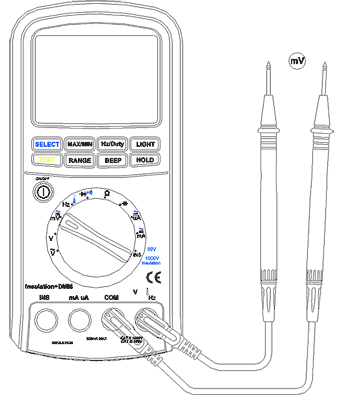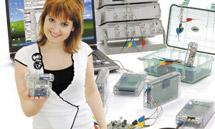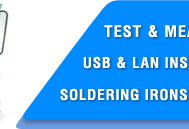Backlight Control
Press the LIGHT key to open the backlight of the LCD screen and after ten seconds the meter will automatically turn off the backlight. It is also possible to turn off the backlight by pressing the LIGHT key before the ten seconds. Lighting the backlight will cause three-times higher energy consumption than the ordinary operation. So by less use of backlight, the electricity can be saved.
DC mV/AC mV Measurement
The testing chart is shown in the Figure. The voltage measurement range is of 0.01mV…500mV and the measurement methods are as follows:
- Turn on the power switch and set the rotary switch to the position
 .
.
- Insert the red testing line into the V end and the black testing line into the COM end.
- Press the SELECT key to select DC mV or AC mV measurement modes.
- When performing DC mV measurement, connect the red probe to the positive polarity of the measured voltage and the black probe to its negative polarity. While performing ACmV measurement, it will be done by connecting the red probe and the black probe into the two ends of the measured voltage.
- Read the measured value from the display screen. If OL displaying on the meter, it indicates the measured voltage exceeding the range of the meter and it is necessary to remove both the red and black probes from the measured circuit immediately.
- When performing DC mV or AC mV measurement, by pressing the RANGE key it is possible to select range manually. The indicator of range indicates the range value. If OL displaying during manual range measurement, it is necessary to select a larger range. If OL displaying under the maximum range, it is necessary to remove both the red and black probes from the measured circuit immediately.
Notes: In case of probe hanging in the air, the voltage inducted by the testing line may cause unstable readings on the display screen, but that will not affect the accuracy of measurement.

DC μA/AC μA Measurement
The measurement is seen in Figure, the measurement range of current is of AC or DC 0.1μA…5000μA, and the measurement methods are as follows:
- Turn on the power switch and set the rotary switch to the position
 .
.
- Insert the red testing line into the mA/μA input end and the black testing line into the COM input end.
- Press the SELECT key to select the DC μA or AC μA measurement modes.
- Turn off the power of the measured circuit, connect the red and black probes to the measured circuit in serial way and then turn on the power of the measured circuit.
- Read the measured value from the display screen. If it displays as positive during the DC measurement, it means the current is flowing into the meter from the red testing line, while it displaying as negative, it means the current is flowing into the meter from the black testing line. If it displays as OL, it means current exceeding range.
- During measurement of DC μA or AC μA,it is possible to select range manually by pressing the RANGE key.

Maximum Value/Minimum Value/Average Value Measurement
By pressing the MAX/MIN key the meter will enter the maximum value, minimum value and average value record state . The meter measures the present value and continuously judges if it is necessary to update the maximum or minimum or average value. Pressing the MAX/MIN key again it is possible to select displaying the minimum value, the maximum value, the average value or the current value in cycles. Under the MAX/MIN measurement state, press the MAX/MIN key for two seconds and then release it, the meter will exit the MAX/MIN record state.
ACV Measurement
The measurement is shown as in Figure, with voltage range being of AC 0.5V…1000V and the measurement methods being as follows:
- Turn on the power switch and set the rotary switch to the position of
 .
.
- Insert the red and black testing lines into V end and COM end respectively.
- Connect the meter to the two ends of the measured voltage with the red and black probes.
- Read the meter’s data from the display screen. When OL displaying on the meter, it indicates the measured voltage exceeding the meter’s range and it is necessary to remove both the red and black probes from the measured circuit immediately.
- By pressing the RANGE key it is possible to select range manually. Indicator of range displays range. While displaying OL during manual range measurement, it is necessary to select a larger range. When OL displaying under the maximum range, it indicates the voltage exceeding 1000V, so it is necessary to remove both the red and black probes from the measured circuit immediately.
Notes: in case of probe hanging in the air, the voltage inducted by the testing line may cause unstable readings on the display screen, but that will not affect the accuracy of measurement.
 Warning! Not try to measure a voltage higher than 1000V
Warning! Not try to measure a voltage higher than 1000V
Capacitance Measurement
The measurement chart is seen in Figure. The measurement range of capacitance is of 0.1nF…1000μF and the measurement methods are as follows:
- Turn on the power switch and set the rotary switch to the position
 .
.
- Insert the red and black testing lines into the V input end and the COM input end respectively.
- If exists voltage in the capacitor, connect the two ends of the capacitor for a short time to discharge.
- Connect the red and black probes to the two ends of the capacitor, if the measured capacitor is heteropolar, it is necessary to connect the red probe to the positive polarity of the capacitor and the black probe to its negative polarity.
- Read the capacitance from the display screen. If capacitance value >1000μF, the meter will display OL, while capacitance value <0.1nF, it will display zero.
- It is possible to select range manually by pressing the RANGE key. The indicator of range indicates the value of range. If OL displaying during manual range measurement, it is necessary to select a larger range. If it has been the largest range, which means capacitance value >1300μF.
Notes: When performing measurement on 500μF-1000μF capacitor, in order to ensure measurement accuracy the meter takes a relative long time to discharge capacitor, so it is relatively slow in refreshing the measured value. In addition, not to perform Capacitance measurement on a circuit board on which there are other parallel devices, for that may leads to very large error.
The measurement results may be related to the quality of capacitance.
DC mA/AC mA Measurements
The measurement range of current is of AC or DC 0.01mA…500mA and the measurement methods are as follows:
- Turn on the power switch and set the rotary switch to the position
 .
.
- Insert the red testing line into the mA/μA input end and the black testing line into the COM input end.
- Press the SELECT key to select the DC mA or AC mA measurement modes.
- Turn off the power of the measured circuit, connect the red and black probes to the measured circuit in a serial way and then turn on the power of the measured circuit again.
- Read the measured value from the display screen. If it displays as positive during DC measurement, it means the current is flowing into the meter from the red testing line, while it displays as negative, it means the current is flowing into the meter from the black testing line. If it displays OL, indicating current exceeding range.
- When performing DC mA or AC mA measurement, it is possible to select range manually by pressing the RANGE key.
DCV Measurement
The measurement is shown in Figure, the range of voltage is of AC or DC 0.5V…1000V and the methods are as follows:
- Turn on the power switch and set the rotary-table switch to the position
 .
.
- Insert the red testing line into the V end and the black testing line into the COM end.
- Connect the red probe to the positive polarity of the measured voltage and the black probe to the negative polarity of the measured voltage.
- Read the measured value from the display screen. If OL displaying on the meter, it indicates the measured voltage exceeding the range of the meter and it is necessary to remove the both red and black probes from the measured circuit immediately.
- By pressing the RANGE key it is possible to select range manually. The indicator of range indicates the range value. If OL displaying during manual range measurement, it is necessary to select a larger range. If OL displaying under the maximum range, it indicates the voltage exceeding 1000V and it is necessary to remove the both red and black probes from the measured circuit immediately.
Notes: in case of probe hanging in the air, the voltage inducted by the testing line may cause unstable readings on the display screen, but that will not affect the accuracy of measurement.
 Warning! Not try to measure a voltage higher than 1000V
Warning! Not try to measure a voltage higher than 1000V
Diode/Continuity Measurement
The measurement range of diode is of 0…2.5V.
The measurement methods are as follows:
- Turn on the power switch and set the rotary switch to the position

 .
.
- Insert the red testing line into the V end and the black testing line into the COM end.
- Press the SELECT key to select diode (
 ) or the continuity (
) or the continuity ( ) modes.
) modes.
- For the diode measurement, connect the red probe to the positive polarity of the diode and the black probe to its negative polarity, while the display screen will display the forward voltage drop.
- Connect the black probe to the positive polarity of the diode and the red probe to its negative polarity, if OL displaying on the display screen, it indicates the backward resistance of the diode being normal, while OL not displaying, it indicates that the diode is backward leaking.
- For the continuity measurement, if the measurement result is less than 25Ω and the buzzer is permitted to sound, the buzzer will sound.
Notes: In case of performing diode or continuity test on circuit board, it is necessary firstly to turn off the power of the circuit board and then perform the measurement. As there may be other parallel circuits, so there will be the difference between the displayed values of test.
Impulse Frequency/Duty Ratio/Temperature Measurement
When performing impulse frequency and duty ratio measurement, the frequency range is of 5Hz…2MHz(Vp 2.5…5V), while the duty ratio measurement range being of 5%…95%. When performing temperature measurement, the temperature range is of -40°C…537°C. And the measurement methods are as follows:
- Turn on the power switch and set the rotary switch to the position
 .
.
- When performing impulse frequency and duty ratio measurement, insert the red testing line into the VΩHz end and the black testing line into the COM end. When performing temperature measurement, insert the positive polarity of the thermocouple into the V end and the negative polarity into the COM end.
- Press the Hz/Duty key to select the logic frequency (Hz) or duty ratio (
 ) modes.
) modes.
- When performing impulse frequency and duty ratio measurement, connect the red testing line to high logic level, the black one to low logic level.
- Read the measured value from the display screen. If the frequency of the measured signal is lower or higher than the meter’s measurement range, the reading will be displayed as zero. If the amplitude of signal is too low or the low level is larger than 1V, the reading will also displayed as zero.
- The impulse frequency and duty ratio measurement is of automatic range, it is null to press the RANGE key.
- Press the SELECT key to select the temperature measurement mode.
- When performing temperature measurement, if the meter’s input end is no-load in the air, the 'OPEN' symbol will be displayed. Insert the positive polarity of the thermocouple into the V end and the negative polarity into the COM end, read the measured value from the display screen. If the measured temperature is higher than the meter’s measurement range, it will display the internal environment temperature and the 'OL' symbol will be displayed.
- Press the RANGE key to select Celsius or Fahrenheit.
Insulation Resistance Measurement
The measurement is seen in Figure, the measurement range of the insulation resistance is 50k---2G and the measurement methods are as follows:
- Turn on the power switch and set the rotary switch to the position INS.
- Insert the black testing line into the mA/μA input end and the red testing line into the insulation test end.
- Connect the red probe and the black probe into the two ends of the measured insulator. Press the RANGE key to select a suitable test voltage range (The measurement range of the insulation resistance corresponding to each range of the measurement voltage are as follows: 50V---10k…50M, 100V---10k…100M, 250V---100k…250M, 500V---100k…500M, 1000V---100k…2G). When performing the insulation resistance measurement, it has not the function of auto-range.
- Press the TEST key to start measuring. If the measured insulation resistance is lower than the meter’s measurement range, it will stop measuring automatically. Pressing the TEST key again during the measurement will also stop measuring.
- When performing the insulation resistance measurement, it has not the function of automatic shutdown.
Note: It will take the initiative to generate high voltage under this function. Please be sure to pay attention when used.
It will take the initiative to generate high voltage under this function. Please be sure to pay attention when used.
Linear Frequency Measurement
The measurement range is of 5Hz∼200kHz and the measurement methods are as follows:
- When performing AC voltage or AC current measurement, it is possible to measure and display the alternating frequency by pressing the Hz/Duty key. However it has a certain requirements for the amplitude of alternating signal and the meter has varied requirements for signal amplitude when it is in different ranges, for information of which please refer to Table.
- If the position of rotary switch is in ACV, after pressing Hz/Duty key the indicator of range will indicates the meter’s present voltage range. In addition, it is possible to change the range by pressing the RANGE key to meet the different voltages.
- Press Hz/Duty key again to exit linear frequency
| Range | Sensibility (sine wave) |
|---|
| 500mV | 100mV |
| 5V | 0.4V |
| 50V | 4V |
| 500V | 40V |
| 1000V | 400V |
| 5000μA | 1mA |
| 500mA | 100mA |
Resistance Measurement
The Measurement chart is seen in Figure. The measurement range of resistance is of 0.1Ω…50MΩ and the measurement methods are as follows:
- Turn on the power switch and set the rotary switch to the position Ω.
- Insert the red and black testing lines into the V input end and the COM input end respectively.
- Connect the red and black probes to the two ends of resistor and read the resistance value from the display screen. If OL displaying, it indicates the resistor is larger than 50MΩ.
- When the resistance measurement mode being implemented, it is possible to select range by pressing the RANGE key. The indicator of range indicates the value of range. If OL displaying during manual range measurement, it is necessary to select a larger range.
Notes: In case of performing resistance test on circuit board, it is necessary firstly to turn off the power of the circuit board and then perform the measurement. As there may be other parallel circuits, so the displayed value of test is not surely the actual value of the resistor.















